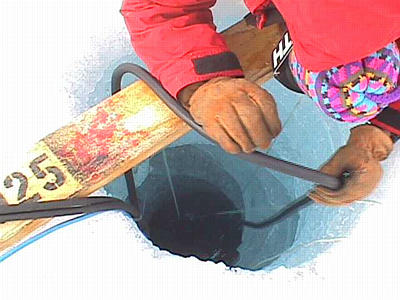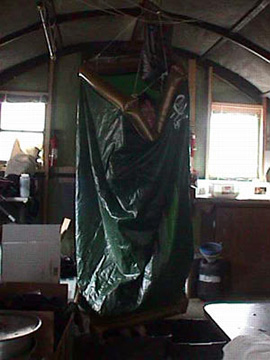
|
|
12 November, 1998
I slept in this morning until 8:30 am. Wow, that felt good! I made
muffins to complement anyone's breakfast plans. [We usually make our
own breakfasts-- cold cereals, hot cereals, dried fruit, toast, etc.]
Today I was planning on pulling up my sediment trap, so I walked out to
my site on the lake and chipped away at ice that had reformed in my
drilled ice hole. I chipped down about 2 feet and then realized that
maybe it would be easier to melt it out. I had heard that sometimes
they use a melting device to do just that. Unfortunately, it was being
used by Ed to melt another hole down into the ice. He is planning on
setting sensors into the ice at certain depths and take readings on them
throughout the year, so he needs to melt about 3 meters down. He'll
also take pictures of the bubble formations and sediment layers in the
ice. I'll just have to wait a couple of days. There really is no
hurry...
I decided to work on measuring the exact GPS (Global Positioning System)
location of my sediment sampling sites from November 6 and 7. This
would help my team relocate those points later if they needed to. GPS
works by using satellite information. The various satellites can tell
exactly where you are at any one time, and this parcticular device (a
Garmin) gathers the satellite information and gives you your
coordinates. It is accurate within about 15 meters (which I think is
pretty incredible!). We had checked out a Garmin device from McMurdo
which I needed to learn how to use. After learning the basics from Ed,
I set out to record my exact sampling locations.
Unfortunately, I realized that the device was not working properly.
After acquiring my position, it kept fluctuating my coordinates (which
should not happen). I am where I am! I wasn't moving...I went back to
camp to talk to Ed. We decided that we needed to initialize it to
recognize the differential system. What that means is that the military
have ways of scrambling your coordinates. This system would allow you
to estimate your real position in spite of the scrambling. That's about
all I understand!
Since I was stuck for a while, I helped the LTER (Long Term Ecological
Research Team) use the PNF (Profiling Natural Fluorometer) to measure
the light incidence in the water column and to measure the fluorescence
of the phytoplankton in the water column. There are basically 2 parts
to the PNF system-- a black disk with a small white ball on top that
stays on the surface of the ice and another long black cylinder with
measuring devices strapped onto its sides that goes down into the water
column. As they lower the cylinder into the water, a computer records
light incidence (how much light is reaching the top of the cylinder)
compared to the white ball on the black disk on the surface. The bottom
of the cylinder measures the red coming up from the phytoplankton (this
is fluorescence). If you remember from your photosynthesis studies,
phytoplankton basically absorbs every light but green and some yellow
light. There is not much red light to absorb at the depths we're
talking about here in the Dry Valley lakes, so the phytoplankton absorb
mostly blue light, and since they have to give off energy, they do so by
giving off red photons (energy). The amount of energy given off (the
fluorescence) tells us about the phytoplankton--whether it exists in the
lake and how active it is. Cool, huh?
I made dinner tonight (scallops in pesto sauce on spinach spaghetti,
fruit salad, corn), and Nina made up a vegetable dish with the fresh
eggplant and carrots that came in as "freshies." It was the LTER team's
last night with us, so John presented them with awards that he had
created on the computer. John was in rare form tonight, so everyone was
up late.
Nina and Ed decided to take showers in the midst of all of this.
Showers in camp are quite the production. You have to sweep the floor
of all the dust (because if you don't, the water that leaks from your
"shower" will create a mudslide). Then there is a shower curtain that
is squarish in shape. The top ring is blown up to create a tube that
will hold the shower's shape. The curtain is attached to the ceiling of
the Jamesway and hangs down to your shins. Your feet go into two
washbins at the bottom, and the solar water shower container is hung
from above the curtain. No, you don't set this water out all day to
heat. You heat water on the stove and then mix it with the cooler
drinking water (that comes from the ice on the lake). So, in the midst
of all the commotion, you can take a relatively private shower, other
than hearing everyone's comments on the other side of the curtain.:)
Needless to say, I never felt the need to shower in camp. I just
collected all the dirt and grime that I could! It's not too bad, as
long as it stays cold...when it starts to warm up (as it's starting to
do), then you begin to smell a little "off."
Before going to bed, Chris went over the nutrient leaching experiments
with me. He is leaving for McMurdo tomorrow and won't be around to help
me if I have any questions. I had sediment samples that I had collected
from my transect sites on November 6 and 7, and we were going to test
how many of the sediment components actually leach (or end up) in the
meltwater. I would basically be sieving the sediments again to gather
the 2 cm, 300 um, 63 um, and smaller increments...adding meltwater from
Lake Bonney to the bottles, incubating them at 0 degrees C, and
extracting and filtering the water off of the sediments at various times
(0 hours, 12 hours, 24 hours, 36 hours, and 48 hours). This would give
us an idea of the rate of leaching (if there is any). As you can see, I
wanted to time it right so I wouldn't be getting up in the middle of the
night. I'll probably begin my experiments at 8:00 pm tomorrow night,
since I need to collect ice from the lake tomorrow and allow time for it
to melt into meltwater.
Bed time was later tonight...midnight. It's amazing how time flies when
it's light outside. I really lose track of time, and my body doesn't
seem to "shut down" as quickly.

Ed checking the progress of his icepit. I don't know if you can see the coil that is at the bottom of the pit, melting the ice. There is boiling glycol running through the coil which is what melts the ice. Ed will be using this pit to house his Water Content Reflectometer sensors (they detect liquid water in the ice) to gather data throughout the coming year.

Nina taking a shower with the Lake Bonney shower setup. Note that it is quite private, other than the few comments you can hear from the other side of the curtain.
Contact the TEA in the field at
.
If you cannot connect through your browser, copy the
TEA's e-mail address in the "To:" line of
your favorite e-mail package.
|
